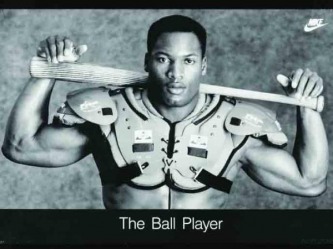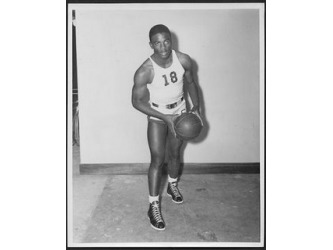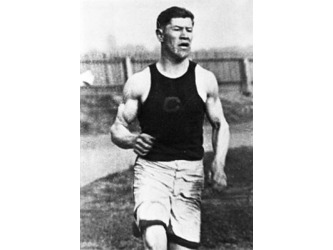Brian Jordan, Danny Ainge, Mark Hendrickson, Todd Helton, Dan Marino, Jim Brown, Kirk Gibson, Julius Peppers, and Charlie Ward (who won the Heisman trophy but opted for the NBA) all deserve honorable mentions, but here are my chosen 10:
10. LeBron James
The current best player in the NBA (see my blog from last week for a lengthy explanation) was also recruited as a wide receiver by college coaches while in high school and was named All-Ohio at the position as a sophomore, before quitting football to focus on his basketball career. (I guess you could say that move worked out well.) There is a commercial playing in which LeBron signs with the Cleveland Browns. Many don’t know that if he wasn’t so good at basketball this may have actually happened.
9. Tom Glavine
Glavine is still in baseball having recently signed a one-year contract with his original team, the one that made him successful and famous, the Atlanta Braves. Glavine returned to the Braves last year after spending five years with the New York Mets. Even with the speculation that he would likely choose baseball, Glavine was chosen in the 4th round, 69th overall by the Los Angeles Kings of the NHL. To put it in perspective – Glavine was drafted ahead of Brett Hull.
8. Antonio Gates
The best tight end in the NFL did not even play football in college. He was recruited as a linebacker, but chose to play basketball instead. After bouncing around a few schools, Gates landed at Kent State University where he became a star. Gates helped Kent State win a MAC championship and advance to the Elite Eight as a junior. As a senior Gates averaged 20.6 points per game and was an honorable mention All-American. After NBA scouts told the 6’4” big-bodied forward that he was a “tweener” and he went undrafted, Gates scheduled workouts with several NFL teams. The first was with the San Diego Chargers, who immediately signed him and turned him into the best tight end in the game today.
7. Joe Mauer
Mauer, a former number one overall draft pick (GREAT call over Mark Prior in retrospect), is arguably the best catcher in Major League Baseball. Though is seems like he’s been around for a while, Mauer is only 25 years old. What many don’t know is that Mauer won multiple awards in football as a quarterback in high school and was offered a scholarship to football powerhouse Florida State. In addition to his personal achievements in high school football, Mauer lead his team to consecutive state championships, winning the Class 5A state championship in 1999. His sideburns could use a trim, but – a great quarterback and a great catcher – this guy is a multi-talented leader.
6. Michael Jordan
Arguably the greatest and most dominant athlete ever, he only makes it this high because of his basketball supremacy. Jordan’s time off from basketball – when he played minor league baseball for the Chicago White Sox – was not a result of his wanting to play baseball as many people believe. He had (and probably still has) a huge gambling problem. NBA Commissioner David Stern did a phenomenal job of keeping it quiet for the benefit of his league. In fairness to Jordan, this came at the same as his father’s murder, so I don’t fault him for taking time away from basketball. Though easily the greatest basketball player of all time, MJ’s baseball foray into baseball was less than impressive. He batted .202 with 3 home runs, 51 runs batted in, and 11 errors in the outfield. His one impressive statistic was his 30 stolen bases.
5. Dave Winfield
Winfield was a first-ballot Hall of Famer, getting immortalized in Cooperstown after a great professional baseball career with the San Diego Padres, New York Yankees and a few other teams. Winfield is one of only a very few professional baseball players to go straight to the major leagues after being drafted, without ever playing in the minor leagues. Winfield’s talents made him the guy with perhaps the most impressive record of being drafted into professional sports. The Padres drafted him number four overall and he was drafted into two professional basketball leagues, the NBA by the Atlanta Hawks and the ABA by the Utah Stars. Not only that, he was also drafted, albeit in the 17th round, by the NFL’s Minnesota Vikings.
4. Deion Sanders
“Prime Time” is the only athlete ever to play in both a World Series and a Super Bowl. There have been a few players who have played both Major League Baseball and in the NFL. Sanders has been the most successful in both sports combined of any of them. “Neon Deion” not only has two great nicknames, he has more swagger than maybe any pro sports figure and is a decent NFL commentator, currently with the NFL Network. Sanders was one of the greatest cornerbacks of all time. In addition to his football prowess, Sanders was a decent baseball player, but actually earned the “Prime Time” nickname for his high school basketball skills and was an assistant coach for the Dallas Fury of the National Women’s Basketball League in 2004. (Cynically though, I have to wonder if he was qualified for the job or if it was a publicity stunt for a league that no one has ever heard of. That’s not me being misogynistic – the WNBA and other women’s leagues are great, but have you ever heard of the NWBL?). 3. Jim Thorpe
The Associated Press named Thorpe the top athlete in the first half of the twentieth century in 1950. The AP named Thorpe the number three athlete of the whole twentieth century in 1999. Thorpe’s biography is fascinating. There is not nearly enough space here to scratch the surface of his athletic accomplishments, let alone what he did in life. Briefly, Thorpe furthered opportunities for Native Americans, not just in sports but in the world, won Olympic gold medals in the multi-event pentathlon and decathlon, and played professional football, baseball, and basketball.
2. Bo Jackson
So how do you beat Jim Thorpe? With an absolute freak of athleticism, easily the most athletic person to play professional sports during my lifetime. Bo Jackson would snap baseball bats over his knee like they were twigs. Can you imagine that? For almost anyone else trying to snap a baseball bat over their knee would likely turn out with the bat still fully intact and the person writhing on the ground. The story of Jackson’s rise from poverty to great athletic achievement is another great read. Jackson won the Heisman at Auburn and ran a 4.12, 4.12!, in the 40 yard dash. And at 6’1” 225 lbs. he was not a small running back. He could have been an Olympic sprinter, but opted for the money offered by the NFL and Major League Baseball. Jackson is the only athlete ever to be named to both a Major League All-Star Game (he the 1989 All-Star Game MVP) and an NFL Pro Bowl. The “Bo knows…” ad campaign was genius (and not that much of a stretch – Jackson also briefly played semi-pro basketball). Unfortunately a hip injury cut him way short of what he could have done, but those who know sports know Bo.
1. Jackie Robinson
Obviously an iconic American hero for what he accomplished to further race relations in the 1950s, Robinson was also arguably the greatest athlete to ever live. Not only was he a great baseball player in his ten seasons with the Brooklyn Dodgers, in 1936 Robinson won the junior boys' singles championship in the annual Pacific Coast Negro Tennis Tournament. Robinson was the first athlete in UCLA history to letter in four sports - baseball, basketball, football, and track. Robinson was the high scorer in basketball in the Pacific Coast Conference – twice. He was also a national champion long jumper. Robinson was an All-American running back. Robinson actually played semi-pro football before ever playing professional baseball. It has been said that baseball was only Robinson’s third or fourth best sport.
-Andrew Sagarin



 RSS Feed
RSS Feed